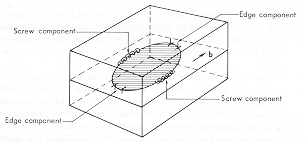|
|
Dislocations
are one-dimensional crystalline defects marking the boundary between
a slipped and an unslipped region of a material. This defect distorts the
regular atomic array of a perfect crystal and is characterized by two vectors,
the Burgers vector, b,
that is a measure of the distortion associated with the defect, and the
unit line vector,
t, that points along the local orientation
of the dislocation. Three generic dislocation types are identified: (1)
Edge dislocations with b
normal to t,
(2) Screw dislocation with b
parallel to t,
and (3) Mixed dislocations for which b
and t
have an arbitrary relative orientation. A dislocation loop has sections
that exhibit each of these characteristics. The Burgers vector of the loop
is the same at each location, the line vector changes direction around
the loop. The slip plane contains b
and t.
If b is a primitive translation vector, the dislocation is a unit dislocation.
Partial dislocations have Burgers vectors smaller than a primitive translation
vector.
Dislocations
are not favored by thermodynamics as they increase the free energy of the
material. The enthalpy of formation of the dislocation is not compensated
by the change in configurational entropy associated with the dislocation. |
|
